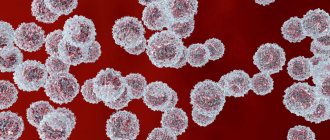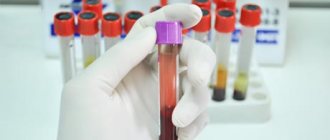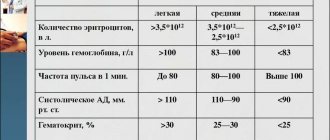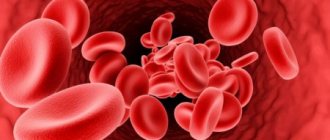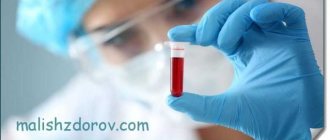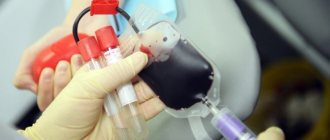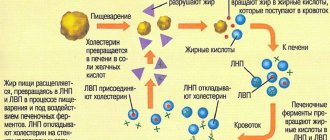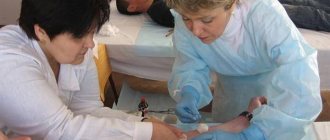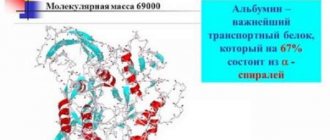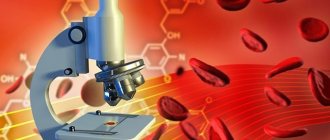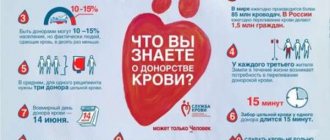0
Author of the article: Marina Dmitrievna
2017.09.23
2 392
Blood analysis
Blood sterility test is a clinical test aimed at identifying pathogenic bacteria in the blood. Allows you to diagnose serious diseases of various etiologies.
Attention! Correct diagnosis of bacterial infections allows you to prescribe effective drug therapy. In recent years, there has been a significant increase in the number of bacterial infections resistant to modern antibiotics. Scientists believe this is due to widespread misprescription of antibacterial drugs.
Known antibacterial drugs
Indications for analysis
Blood sampling for sterility is not carried out as part of preventive medical examination and is not mandatory when entering work (study). The study is indicated under certain conditions:
- prolonged low-grade fever (37-38 °C) of the body, not accompanied by other abnormal changes in health;
- diseases associated with immunodeficiency (AIDS, HIV);
- preoperative preparation (to assess the patient’s health status);
- postoperative period (as a prevention of possible complications);
- specific symptoms that cannot be eradicated (liquidated) through antibacterial therapy;
- the presence of an implant in the body (artificial myocardial valves, etc.);
- chronic furunculosis and other pathologies accompanied by purulent infiltrates;
- before placing an internal catheter for a long time and after its removal.
It is recommended that cancer patients undergo a study after a course of chemotherapy, since such treatment suppresses the body's immune defense. The analysis is prescribed to diagnose suspected bacterial infections, according to the patient's symptomatic complaints.
For a newborn baby, blood sampling for sterility is carried out in the following cases:
- pyretic body temperature (39-41°C) immediately after birth;
- complicated pregnancy (infection of a woman with a staphylococcal infection during the perinatal period);
- the presence of genetic abnormalities identified during screening of a pregnant woman or after delivery;
- bacterial inflammation of the bottom of the umbilical wound in an infant (omphalitis).
If necessary, assessment of the sterility of the newborn’s blood is carried out under the condition of premature rapid delivery.
What testing reveals
In most cases, bacterial culture for sterility is prescribed to detect harmful bacteria and microbes in the blood, such as:
- staphylococci;
- streptococci;
- yeast fungi;
- mold spores;
- enterobacteria.
This study is necessary for patients who have reduced body defenses, as well as for people suffering from dangerous pathologies such as HIV, tuberculosis, and acute infectious diseases. In addition, testing is often prescribed if doctors cannot decide on the optimal treatment regimen.
Research Opportunities
What does bacteriological blood culture show for sterility? First of all, the analysis reveals the very presence of bacteremia. Next, a blood culture of the pathogenic microorganism is isolated. The main pathogens determined during the sterility test are:
- bacteria of the cocci family (staphylococci, streptococci, gonococci, pneumococci, meningococci, etc.);
- enterobacteria (klebsiella, salmonella, E. coli and others);
- yeast and yeast-like fungi;
- Koch's wand.
Important! High activity of pathogens in the blood can lead to the development of pathologies incompatible with life.
Pyoderma of the frontal region (photo) - indication for a blood test for sterility
According to the type of bacteria that were discovered during the study, the patient may be diagnosed with:
Urine microflora analysis
- Meningitis is an infectious and inflammatory pathology of the membranes of the brain and spinal cord. With the diplococcal variety of the disease, pathogens enter the blood through the nasopharynx, respiratory tract, and gastrointestinal tract. Through the vessels, diplococci reach the brain, which leads to damage to the central nervous system (CNS) and cerebrospinal fluid (CSF). If not diagnosed in a timely manner, infection can be fatal.
- Pyoderma is a skin inflammation caused by pyogenic cocci (staphylococci and streptococci) that penetrate into the blood through lesions on the skin.
- Osteomyelitis is an inflammatory lesion of the bone marrow involving the bones. It is purulent-necrotic in nature and poses a risk of numerous complications of the musculoskeletal system. In 90% of cases it occurs due to infection with Staphylococcus aureus.
- Tuberculosis - infection with Koch's bacillus. The most common form of the disease is the pulmonary form. Bones, kidneys, bladder, and peripheral lymph nodes may also be affected.
- Sepsis is a deadly secondary purulent infection caused by gram-positive coccal bacteria or gram-negative pathogens (pseudomonas and Escherichia coli, Klebsiella, etc.). Blood poisoning quickly spreads to all organs and systems, the mortality rate ranges from 15 to 45%.
- Endocarditis is an inflammation of the connective tissue membrane of the heart, staphylococcal or enterococcal in nature. With embolism (transferred by blood), the infection can spread to other organs. A typical complication is cardiac and multiple organ failure.
Given the seriousness of diseases caused by bacteremia, it is extremely important to promptly identify the pathogen and begin urgent treatment.
Rules for collecting and inoculating blood for sterility and blood culture
Flush the stomach of a patient with PTI
At the first signs of food poisoning (nausea, vomiting, abdominal pain, tenesmus, diarrhea), the patient needs to rinse the stomach by asking him to drink a liquid or by introducing it into the stomach through a tube. The procedure can be repeated at a later date if nausea and vomiting continue. For this purpose, use a 2% solution of sodium bicarbonate, a weak solution of potassium permanganate or ordinary boiled water. Rinsing is carried out until the rinsing waters become clean, without lumps of undigested food and mucus. Frequent vomiting and loose stools lead to dehydration of the body, so the patient, depending on the severity of his condition, is prescribed rehydration treatment for food toxicoinfection in children using rehydron, quartasol, trisol orally. Infusion rehydration therapy is indicated in more severe cases, with toxicosis with exicosis, and in this case, a 5% glucose solution, saline solutions, and Ringer-Locke solution are prescribed. Detoxification therapy includes the prescription of hemodez, polyglucin, reopolyglucin, which improve blood circulation and relieve symptoms of intoxication. Antipyretic and anticonvulsants and glucocorticoids are also prescribed. In case of severe pain, antispasmodics are prescribed.
nutritional features of infectious patients
Basic rules for therapeutic nutrition of an infectious patient
The founder of Russian dietetics, M.I. Pevzner, developed diet No. 13 for infectious patients, and recommended following the following rules when preparing a diet for an infectious patient:
A febrile patient should not be allowed to go hungry. He should receive enough food, but in small portions at a time.
Any overfeeding is contraindicated, even if the patient has an appetite.
If possible, you should exclude from your diet foods that mechanically irritate the digestive organs.
It is necessary to monitor the function of the excretory organs and, in case of constipation, include in the diet foods that have a laxative effect (sugar, honey, juices of raw vegetables, fruits and berries), and in case of diarrhea, exclude pure milk, cold drinks and limit the amount of sugar.
In case of kidney symptoms, it is necessary to exclude strong broths, extractives, and spices from the diet.
It is necessary to take into account the state of the patient’s nervous system, allowing the introduction into the diet of only a small amount of nutrients that irritate the nervous system (strong coffee, tea, very strong broth), or even excluding them completely.
During acute infections, the body's need for vitamins increases significantly. Of particular value are vitamins that in one way or another affect the state of the immune system. The richest foods in vitamin C are rose hips, black currants, citrus fruits, and sea buckthorn. Food sources of vitamin A: liver, beluga caviar, egg yolk, butter, hard cheeses. Vitamin B2 (riboflavin) is found in large quantities in offal, yeast, almonds, cheeses, eggs, and cottage cheese. Vitamin B6 (pyridoxine) is found in offal, meat, beans, soybeans, rice, millet, and potatoes. D improves the state of anti-tuberculosis and antifungal immunity. Food sources of vitamin D: liver oil of fish and marine animals, salmon, herring, mackerel, caviar, tuna, egg, cream, sour cream.
Among the microelements, the most important for the state of the immune system is zinc, deficiency of which develops with enteritis, especially in patients who abuse alcohol. Food sources of zinc: shellfish, mushrooms, egg yolk, liver, meat. Legumes, sesame, and peanuts also contain a lot of zinc, but it is associated with phytic acid. The daily requirement for zinc is 15–25 mg.
Stages of diet therapy for infectious diseases
Against the background of a high fever, it is quite acceptable to only drink thirst-quenching drinks for 1-2 days; the patient should not be forced to eat. If fever continues for more than 5–7 days, enteral or parenteral nutrition should be prescribed.
When the patient's condition improves after a drop in body temperature, an increase in appetite is often noted. However, there is no need to strive to completely satisfy it from the very beginning, since in the first 3-4 days temperature fluctuations are observed for some time, and the production of gastrointestinal enzymes is disrupted. That is why you should not sharply expand your diet during these 3-4 days.
With further expansion of the diet, the greatest attention should be paid to replenishing protein and vitamin deficiencies. Either diet No. 11 or diet No. 15 is used. The amount of protein in the diet should be 1.5 g/kg of ideal body weight, while the quota of fats and carbohydrates corresponds to the norms of a balanced diet. Convalescents are prescribed a diet with a restriction of foods that stimulate the central nervous system (strong coffee, tea, strong broths, spices, chocolate) and foods containing coarse fiber and essential oils (rutabaga, turnip, garlic, radish, radish). Cakes, pastries, and shortcrust pastry products are not shown. All types of culinary processing are allowed: boiling, stewing, baking and frying without breading. The diet is 3-4 times a day.
Sometimes convalescents may experience dyspeptic symptoms due to a rapid expansion of the diet. In this case, it is necessary to appoint a fasting day (boiled vegetables without salt and oil, baked apples) and check whether the diet is composed correctly, whether the patient has taken into account the presence of concomitant chronic diseases of the digestive system, and, if necessary, make appropriate adjustments.
Blood collection for typhoid fever
Technique for collecting blood for culture
.
With strict adherence to sterility, draw 5-10 cm3 of blood from the cubital vein into a Record or Luer syringe, remove the needle with tweezers, burn the cannula of the syringe on an alcohol flame and then pour the blood into the flask with the medium; Burn the neck of the flask and the stopper before closing. Either broth or bile (50-100 cm3 of medium) is used as a nutrient medium. Technique for collecting blood for agglutination (Vidal reaction).
From the flesh of the finger, pump 1.5-2 cm3 of blood into a sterile Pasteur pipette and, when full, seal it or draw 3-5 cm3 of blood from the cubital vein with a syringe, which is then poured into a sterile test tube.
Store the collected blood in a cool place. If necessary, you can use filter paper; to do this, collect 2-3 falling drops of blood on a piece of paper measuring 5x10 cm, dry it in air, and send it in a sealed envelope for testing to the laboratory. Stool collection technique
. Collection vessels (vessels, jars, etc.) should not be subjected to chemical treatment, but only to boiling. To better preserve the viability of microbes, it is recommended to mix feces with an equal volume of a preservative (30% glycerol solution in saline).
It is performed for typhoid-paratyphoid diseases, sepsis, meningococcal infection or other infections accompanied by fever, throughout the entire febrile period of the disease, but better in the initial period or at the height of the disease (with severe bacteremia). For the study, blood is taken from a vein in the elbow; in small children, blood is taken in smaller quantities from the earlobe, heel, and finger. Blood samples are taken after thorough skin preparation in compliance with aseptic rules, using a disposable sterile syringe. Inoculation of sterile material (blood or other liquids containing microbes in healthy individuals) on nutrient media is also best done at the patient’s bedside, or placed in a sterile container containing substances that prevent blood clotting, 0.3% sodium citrate solution, 0.1% solution sodium oxalate). Typically, 5-10 ml of blood is taken and inoculated into a vial containing 50-100 ml of medium. To do this, use a bottle with a nutrient medium (one for aerobes, the other for anaerobes). Blood culture is carried out on liquid nutrient media - 10% bile broth, 1% sugar broth, two-phase medium, as well as liquid and semi-liquid media for the cultivation of anaerobes at a dilution of 1:10. Vials with a nutrient medium are obtained in the laboratory; blood transfusion from a syringe into a vial must be done over the flame of an alcohol lamp, after removing the needle. The vial with the inoculation is sent to the laboratory, and in the evening and at night it is placed in a thermostat. It is important for the student to remember that the earlier from the onset of the disease the culture is performed. The greater the chance of getting a positive result. And, conversely, the later the blood is taken, the smaller the amount of pathogen in it and the less often positive results are obtained. And at normal temperatures - very rarely. You should know that to increase the number of positive results of blood culture, it is recommended, in the absence of contraindications, to inject subcutaneously 1 ml of a 0.1% solution of adrenaline 15-20 minutes before drawing blood, which promotes contraction of the spleen and the release of pathogens into the bloodstream (for example, with typhoid fever). paratyphoid diseases) The preliminary result of culture for typhoid-paratyphoid diseases is obtained after 2-3 days, and the final result - after 7-10 days. It should be remembered that increasing the frequency of blood cultures (three days in a row with a rise in temperature) significantly increases the frequency of microbial isolation from the blood. In treated patients, blood for culture should be taken 5-6 times.
Lumbar puncture
conducted by a doctor.
The nurse carries out: - preparing instruments; — preparing the patient; — assistance to the doctor during manipulation; — ensuring proper care for the patient after the puncture.
The purpose of a lumbar puncture is therapeutic and diagnostic.
Equipment. Sterile cotton balls, tweezers, 3% alcohol solution of iodine (iodinol), syringe 2.0 ml or 5.0 ml, two needles, 0.5% novocaine solution, spinal puncture needle with mandrin, sterile test tubes, alcohol, sterile wipes , adhesive plaster, sterile rubber gloves, referral forms to the clinical and bacteriological laboratory.
1. Place the patient in a sitting position, bending forward, or lying on his side with his knees brought to the stomach.
2. Disinfect your hands and wear sterile rubber gloves.
3. Treat the puncture site (the point between the fourth and fifth lumbar vertebrae) and the surrounding area with an alcohol solution of iodine (iodinol).
4. Anesthetize the skin with novocaine.
5. Perform a lumbar puncture: insert a needle with a mandrin into the point between the spinous processes of the fourth and fifth lumbar vertebrae.
6. Remove the mandrin (liquid should flow out of the needle in a stream or drop) and substitute a sterile test tube. Collect the required amount of liquid for testing.
7. Insert the mandrel into the needle and carefully remove the needle.
8. Treat the puncture site and apply a sterile bandage.
Note: - the patient is transported to the ward in a horizontal position, lying on his stomach, on a gurney; - for the first 2-3 hours the patient should lie on his stomach without a pillow; - Strict bed rest is required during the day.
Preparatory activities
Before the collection procedure for bacteriological culture, preliminary preparation of the organism is carried out, provided for by the rules of clinical and laboratory examination. The patient's responsibilities include the following. 5-6 days before the planned analysis, interrupt antibacterial and antiviral therapy (if any) and do not use homeopathic remedies.
For 3-5 days, exclude the use of carbonated and alcoholic drinks, three days before the procedure, eliminate heavy foods (meat, mushrooms), fatty and spicy foods, and dishes prepared by frying from the daily menu. On the eve of Bak-sowing, limit sports training and other physical activities, observe a fasting regime of 8-10 hours.
Immediately before donating blood, you must quit nicotine (do not smoke). Neglecting the rules of preliminary preparation will not allow you to obtain a reliable analysis result. Accordingly, the prescribed treatment will be erroneous and ineffective.
Features of the procedure
To obtain objective data, the laboratory assistant needs to take biofluid for analysis twice or three times (with a time interval of 30 minutes) from different veins. The main condition for the procedure is absolute sterility. The use of a catheter is prohibited due to the possible release of microorganisms from it into the blood sample.
The biomaterial is taken using a disposable consumable (scarifier, or lancet, syringe, gloves), which must be disposed of after the procedure. The informativeness and reliability of the research results largely depends on how clearly the laboratory technician follows the rules for collecting blood:
- consumables are opened immediately before use;
- the patient’s skin at the site of the intended puncture is carefully treated with an antiseptic;
- 10 ml of biological fluid is drawn into the syringe (a smaller amount may not be suitable for study);
- the needle is removed from the syringe over a burning burner (this ensures maximum purity of the biomaterial), the biofluid is immediately transferred to a test tube containing a nutrient medium;
- the tube is hermetically sealed and placed in a specialized container.
In adults, blood for testing is taken from a vein. For children, the option of collecting capillary blood (from a finger) is possible. In infants, the heel is pierced. According to indications, an intravenous injection of adrenaline is provided for an adult 30 minutes before blood sampling. Why is this necessary?
When adrenaline levels increase, the blood vessels of the abdominal cavity narrow and blood circulation accelerates, which causes a powerful release of bacteria into the bloodstream. This provocation allows you to determine the maximum concentration of microbes.
Carrying out the procedure in adults
The algorithm of actions is very simple, but the most important point is to follow the fence technique. The biomaterial must be taken strictly from the vein of the elbow. The physician must ensure that no external contaminants enter the bloodstream.
To prevent damage to the biomaterial, blood is drawn using a disposable sterile needle.
Before starting, the area of the epidermis must be treated with an antiseptic solution. In most cases, about 10 ml of biomaterial is taken from the patient, after which it is placed in a bottle with a nutrient medium that prevents changes in the structure of the blood.
To reduce the risk of infection, blood is poured from a syringe into a vial placed above the burner flame.
. After these steps, the vial is sealed with a tight lid and placed in a special container until further research is carried out.
In the rarest cases, the patient is injected with adrenaline before blood sampling, since the substance increases the accuracy of the analysis and helps to identify the maximum number of pathogens.
Methodology for carrying out BAC seeding
The samples under study are placed in a nutrient medium favorable for the reproduction and growth of bacteria. To further study the bacteriological composition of blood, a special laboratory container (Petri dish) is used.
BAK-culture for sterility in Petri dishes
The two-stage research algorithm is as follows. Initially, a sample of the biomaterial is placed in a container with a nutrient medium and kept in a thermostat for several days. In the presence of pathogenic microorganisms, they begin to multiply, forming colonies.
The study analyzes the number of CFU (colony-forming units), that is, the number of bacteria in one milliliter of nutrient medium. The number of colonies corresponds to the severity of infection. The type of pathogen is determined visually (with the naked eye) or using a microscope.
At the second stage, sensitivity to antibiotics is determined. The detected microorganisms are sown in a laboratory container, along the edges of which test disks soaked in solutions of various antibiotics are distributed. Evaluation of the result determines the tactics of further therapy.
A disc that is not contaminated with bacteria is an example of a drug that can destroy microorganisms. The physical state of the nutrient medium can be solid or liquid. In the first case, solid agar is used, in the second, agar broth is used.
Reference! Agar-agar is a natural polysaccharide consisting of agarose and agaropectin. The most common use of the substance is in cooking as a stabilizer (thickener).
How long does the analysis take? It takes at least ten days to grow a full-fledged colony and determine the resistance of pathogens to antibiotics. It is impossible to forcefully speed up the process, as this will distort the result.
What diseases can culture help identify?
Testing for the presence of pathogenic microorganisms allows us to determine the presence of the following pathologies:
- Meningitis.
- Pyoderma.
- Endocarditis.
- Osteomyelitis.
To detect the type of blood culture, a thorough analysis of the suspected pathogen is required. If the study shows its presence in the body, doctors will need to find out how serious a danger the detected microbes pose to various systems and internal organs.
Only after receiving the necessary information will doctors be able to prescribe optimal therapy for the patient.
